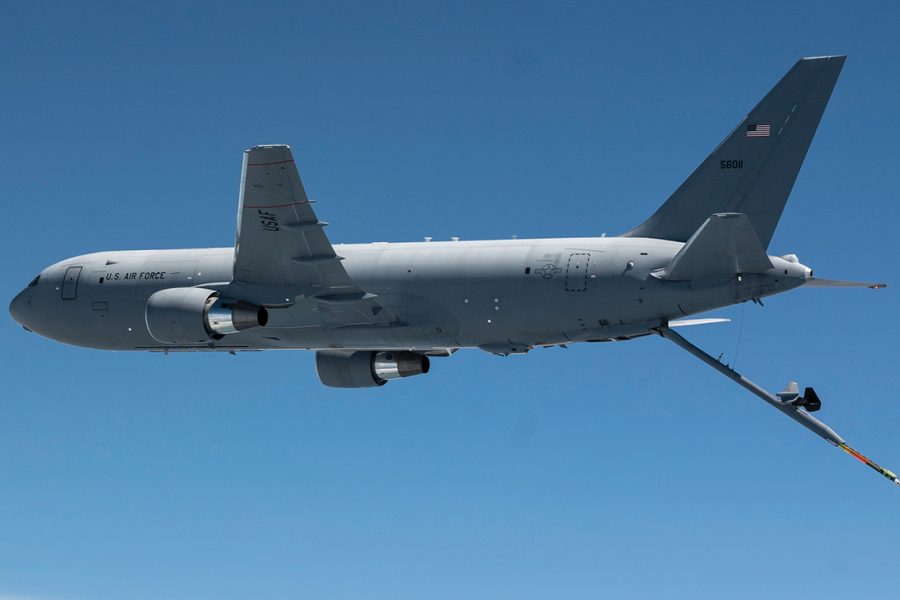Boeing’s receipt of the 10th lot contract award for the KC-46 Pegasus this week leaves just three lots left to complete the Air Force’s buy of the tanker, although a further buy of 75 additional aircraft as a “bridge” to the Next-Generation Aerial-refueling System (NGAS) seems increasingly likely.
Boeing received a $2.3 billion award on Nov. 28 for a further 15 KC-46s, to be delivered by mid-2027. The award brings Boeing up to 143 aircraft on order under the fixed-price contract, leaving just 36 more to fill out the planned buy of 179 aircraft. The company has delivered 76 aircraft to the Air Force so far. The previous lot was awarded in January—also for $2.3 billion and 15 aircraft.
The existing firm-fixed-price contract limits the KC-46 program to 13 lots, the last of which is to be awarded in 2027. The last aircraft is to be delivered two years later. How many will be in each of the last few lots has not been determined.
Boeing has so far written down more than $7 billion in losses on the program, which has suffered delays due to problems with the boom operator’s Remote Viewing System, boom stiffness, and supply chain and labor issues, among others. Boeing president and chief executive officer David Calhoun has pledged to shareholders that the company won’t be making any more lowball bids on defense contracts in order to secure long-term work.
Shortly after Boeing won the KC-46 contract in 2011, company officials said they believed some losses on the program were acceptable because they expected the type to become the global standard tanker, much as Boeing’s C-17 became the world standard oversize jet cargo plane. But the KC-46 has lost out on most tanker contests to the Airbus A330 Multi-Role Tanker Transport (MRTT). Internationally, Israel and Japan are the only customers so far for the KC-46, ordering four and six, respectively, although a sale to Italy seems likely.
In late October, Lockheed Martin announced it would not bid its LMXT air refueling plane—based on the MRTT, in partnership with Airbus—for the USAF’s “bridge tanker” requirement. Airbus subsequently said it will pursue the work on its own, but the Air Force has not committed to holding a bridge tanker competition. Air Force Secretary Frank Kendall has voiced skepticism that a competition would be worth the cost, given the size of the buy and the need to potentially create a new and unique organic logistics capability.
Kendall and Air Force acquisition executive Andrew Hunter have said the bridge tanker is meant to keep a USAF tanker in production until the NGAS—formerly the KC-Z—is developed and readied for service, sometime in the mid-2030s. The NGAS is to be a smaller aircraft with signature reduction meant to escort fighters, bombers, and Collaborative Combat Aircraft (CCAs) into contested airspace, where standard “tube and wing” commercially-derived aircraft like the KC-46 and MRTT cannot survive. While 75 is considered the minimum size fleet for the bridge tanker, USAF officials have said up to 150 may be bought if there are delays with the NGAS.
A Boeing spokesperson said the company will “continue to support the Air Force through the Analysis of Alternatives” for the bridge tanker, which Hunter told Congress in the spring would get underway this fall.
“We are confident that the U.S. Air Force will pursue the appropriate acquisition strategy to continue the recapitalization of the tanker fleet and meet the needs of the warfighter,” the Boeing spokesperson said.
In August, the Air Force picked JetZero to design and prototype a blended-wing-body (BWB) aircraft which will explore future tanker and cargo aircraft concepts. Northrop Grumman, which builds the B-21 bomber, is partnered with JetZero. The Air Force has said the BWB program will not necessarily lead directly to the NGAS.
Before withdrawing the LMXT, Lockheed touted the aircraft—which is substantially larger than the KC-46—as being a “mothership” for CCAs, able to stay on station just outside contested airspace for long periods, refueling combat jets as they enter and leave the battle zone. Airbus is likely to make a similar pitch.
Although not yet declared “operational,” the KC-46 has been performing real-world missions and participated in last summer’s Mobility Guardian exercise, making extended flights in excess of 30 hours.
Air Mobility Command has certified the KC-46 to refuel all Air Force types except the A-10, which must be air-refueled by the KC-135, the Eisenhower-era tanker which is expected to be ultimately replaced by the bridge tanker and NGAS.
The Air Force is also upgrading its KC-46s with enhanced communication suites and plans to make the aircraft a communications relay node.
Thus far, the KC-46 fleet has logged more than 18,600 total flights, with 104,000 boom aerial refueling contacts and 183 million pounds of fuel offloaded, according to Boeing.


